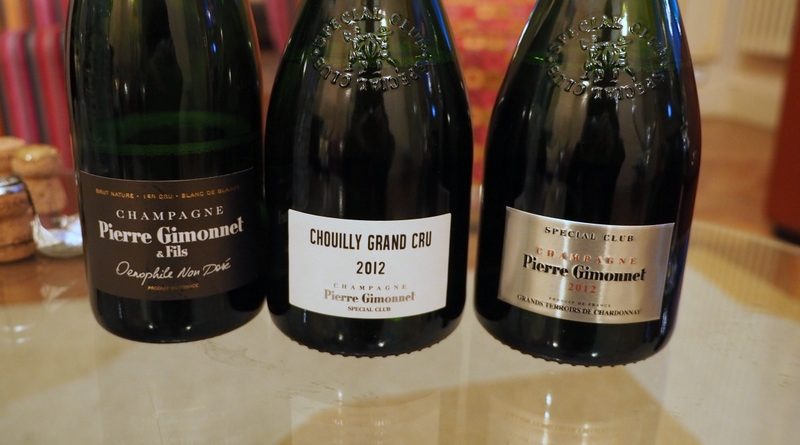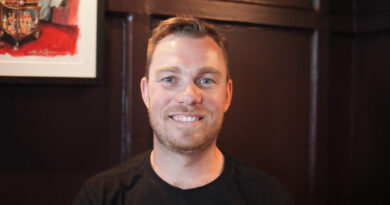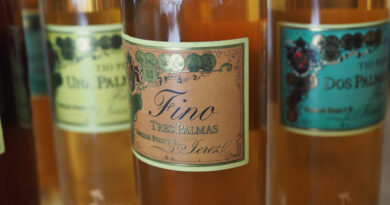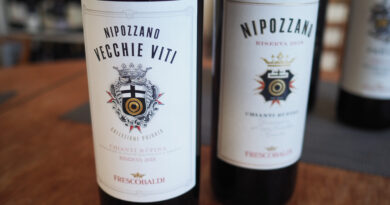In Champagne : Pierre Gimonnet et Fils
‘At Gimonnet we are atypical for many reasons,’ says Didier Gimonnet, third generation grower and producer. ‘The first is because we are producing mostly Blanc de Blancs Champagne. It’s 98% of our production.’
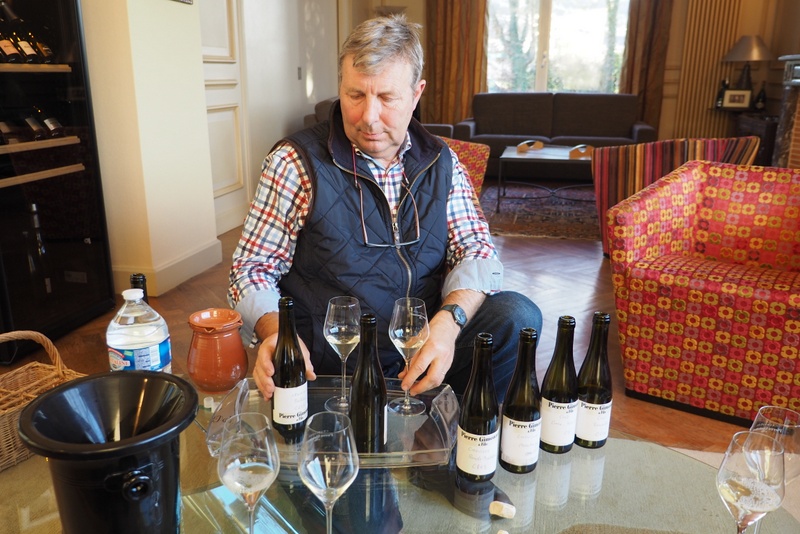
Didier oversees the winemaking and viticulture of the 28 hectare estate, Pierre Gimonnet et Fils, while his brother, Olivier takes care of of the business side. Their family has been growing grapes in Cuis, where they are still based, since 1750. In 1955, their father, Michel, took control of the property, steering the winery’s characteristic chiselled, crisp, and mineral-driven blanc de blancs. Michel began vinifying each plot separately, in stainless, to better understand and represent their distinct terroir.
Bollinger is the biggest owner in Cuis with 30 hectares: they get most of their Chardonnay from here. But Gimonnet is the largest grower here, with 14 hectares in their premier cru village of Cuis. Didier points out that there are just five presses in Cuis, which is not a lot for a village. Historically it’s a village where there are people who are farmers as well as winegrowers. Gimonnet also have 170 hectares of wheat and barley, as well as their vineyards. Didier’s grandfather started making wine under the Gimonnet label in the 1920s, so now they have almost a century of history.
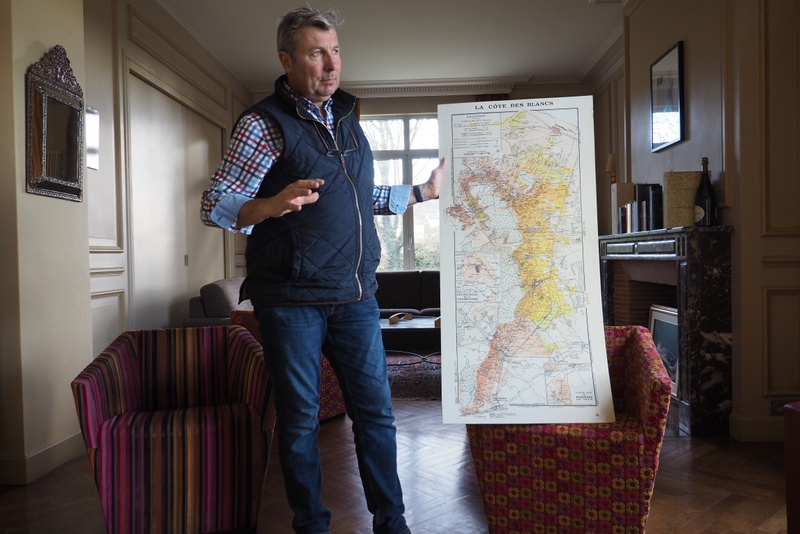
Today Gimmonet is one of the biggest growers (RMs) in the Côte de Blancs, including 17 hectares are premier cru. They purchased 2 hectares in Vertus, in the south of Côte des Blancs. Their 12 hectares of Grand Cru are mostly in the north, with 11 hectares in Cramant and Chouilly, and one in Oger. Seventy percent of Gimonnet’s holdings are over 30 years old, some 40% are more than 40 years old, and they’ve 100+ year old vines in the lieux-dits of Le Fond du Bateau, planted in 1911, and Buisson planted in 1913, both in Cramant.
‘I think it is very important to be precise about the location of the vines,’ says Didier, pointing out where exactly in the Grand Crus his plots are situated. ‘Our Champagnes are elaborated mainly from the north of the Côte des Blancs. The north is very different from the south. For example, our vines in Oger and Vertus are very different from Cramant, Chouilly or Cuis. If I can try to explain the difference between the style of the north and south, Pierre Peters is an example of the style of the south, and their wines have more power than those of the north, and in the north for me it is more delicate with very chalky lines. The style is completely different.’
It’s always been Didier’s philosophy to blend the grand cru fruit into his premier cru wines, raising the quality, and keeping the price more accessible to all.

While blending is in the Champagne DNA, it’s not always easy, especially when you’re trying to make wines of a specific place. ‘In 2005 when we bought a hectare in Oger, in the beginning I tried to blend Oger with wines of Gimonnet, and in fact it was not as easy as I was expecting. Oger is changing the style of Gimonnet, and ageing more rapidly than Cuis.’
As a result, since 2011 he’s only blended in a small amount of Oger in the vintage wines to give them more structure, but not so much that he disturbs the house style. ‘I also use Oger in the Rosé, but never in the Special Club. I started to produce a single Oger in 2011. This is absolutely the opposite of what I am thinking. I like to have wine with the identity of Champagne, and the identity of Champagne for me is blending. When you are blending different components together, generally the result is that the blend is always better than the best component. But as you know, it is very trendy to make Champagne like Burgundy with more single village or single plot wines. So since 2012 I have started to produce a few bottles of single terroir in Cramant, Chouilly and Oger. It is amazing for me because it is completely the opposite of what I am thinking.’
‘But it is the exception that explains the rules. It is disturbing a lot of my thinking because I always prefer the blend. But I have some importers or customers who want the single village wines. It could be good to have something very authentic. But the knowledge of the growers is to know which terroir they are using to try to make the best pairing between the different villages to have something harmonious and more complex, and better for ageing.’
Didier buys some grapes in, but is still an grower by the official definition. ‘Every year you can buy 5% from outside,’ he says. He purchases 7000 litres of red wine to make 20 000 bottles of rosé. ‘I want to have a rosé that tastes like a blanc de blancs with colour. It should taste like powerful chardonnay.’
Didier has lots to say about the heralded 2018 vintage. ‘I am not so optimistic as many people are. I think it is extraordinary because it is not an ordinary vintage. What is very interesting for the region is that we don’t have any bad things. This means we have large volumes with no rot, so we have still wine without organoleptic deviation. There is a lot of ripeness, so there are no herbal flavours. For Champagne it is absolutely fantastic. When you have volume you are not using the taille (it is going to the distillery), and you have no bad things to use.’
He thinks 2018 will be a year for non-vintage wines. ‘I think this is a chance for Champagne because NV is normally 80% of the production of the region. This means the base for Champagnes in 2018 are fantastic, and everyone is going to produce something very drinkable.’
‘Is 2018 the vintage of the century?’ asks Didier. ‘Absolutely not. 2018 doesn’t have the identity of Champagne. It doesn’t have the structure of exceptional vintages like 2002 and 2008 or 2012. The 2018s are rich and don’t have a lot of acidity. For the style of Gimonnet it isn’t the best: it doesn’t have the freshness or the energy, or the saltiness we expect. But of course we will make a vintage, because it is a good vintage and it has a huge identity, so it will be very easy to sell.’
He does say, though, that has has some very good wines from this year. ‘I will make one short cuvée with a blend that I have never done, but it is not in the identity of the exceptional vintages of Gimonnet.’ What will this be? ‘It will be 100% Cuis as a Special Club cuvée. I have never done this before. Cuis is not a great terroir: it is a difficult terroir generally. It is harder to get ripeness because we have part on clay, not just on chalk. And we have some vines with a north exposition. So it is hard to obtain an optimum ripeness in Cuis.’
With no rot in 2018, Didier was able to wait. His goal was to allow 100 days between blooming and harvest: an unusually long cycle. ‘I wanted to take the risk to have a cycle of 100 days, and with this I have obtained a ripeness I’ve never had before in Cuis. We finished [harvest] on 11 September. The beginning in the Cotes des Blanc was 28 August. On the last day, the natural alcoholic potential was 12.55. This was completely crazy.’
‘I harvested 200 hl like this on the 10th and 11th September. I have enough to try to create a Special Club 100% Cuis. There was too much body in this wine so I will blend it with more traditional Cuis.’
‘It was a fantastic year to imagine something we never imagined. I thought at the beginning that I was going to produce a white Coteaux Champenois still wine, but this is not the style of the house. To do this I need to use oak, and my philosophy is to produce all the wine in stainless steel to try to have no influence of vinification on the style of the wine. To make this style you need to have the right date of harvest to have the best ripeness possible. Because you have no influence of oak to give the structure to the wine. The structure comes only from the grapes and the ripeness.’
Didier says that normally he prefers the wines from chalk, but in such as ripe year as 2018 those on clay were also really good. He doesn’t stir the lees because he prefers elegance to concentration. ‘We prefer harmony to intensity,’ he says, ‘so we need phenolic maturation.’ He thinks the length of the vine cycle, which has been decreasing with climate change, is very important. ‘When you reduce the cycle you have less complexity and less acidity than 20 years ago. You have the identity of the vintage but not the identity of the vineyard.’
Key to their characteristic crisp style, Gimonnet keep all their reserve wines in magnums, under crown cap, rather than tank. Their NV wines are always a blend of different vintages to active that house style, with 60-70% is based on the most recent harvest. Didier doesn’t like the perpetual/solera reserve wine concept because he wants precise control over the composition of the reserve wines, utilizing his reserve vintages like ‘medicine’ to complement the base year. In 2018, reserve wines are very important. ‘I need reserve wines with energy and acidity.’ Didier bottled the 2018-base NV with 35% reserve wines, including 9% of 2014 and 9% of 2016. ‘They were vintages with energy and freshness.’ He adds 5 g sugar and some yeast to his reserve wine magnums for a small fermentation. ‘Reserve wines kept under gas are better than in tank: the evolution is better and you keep the freshness, and the lees from the fermentation support the wine. They are more toasty with flavours of brioche and butter.’ He has been doing this since 1982: it’s something Bollinger do with some of their reserve wines too.
In terms of the dosage, Didier says that it is part of the balance. ‘What is important to me is whether the wine is balanced or not. It is very trendy to ask what is the dosage? I ask: why? Is there a problem with the wine?’ He adds, ‘Non-dosage wines don’t have the longevity. That is why I am against that.’ He uses larger dosages for keeping the wine longer. ‘You cannot detect the sugar in the wine in older wines. The sugar is doing something to preserve the wine: it is better to add sugar than sulfites.’
Total production at Gimonnet is 250 000 bottles, of which 180 000 are exported.
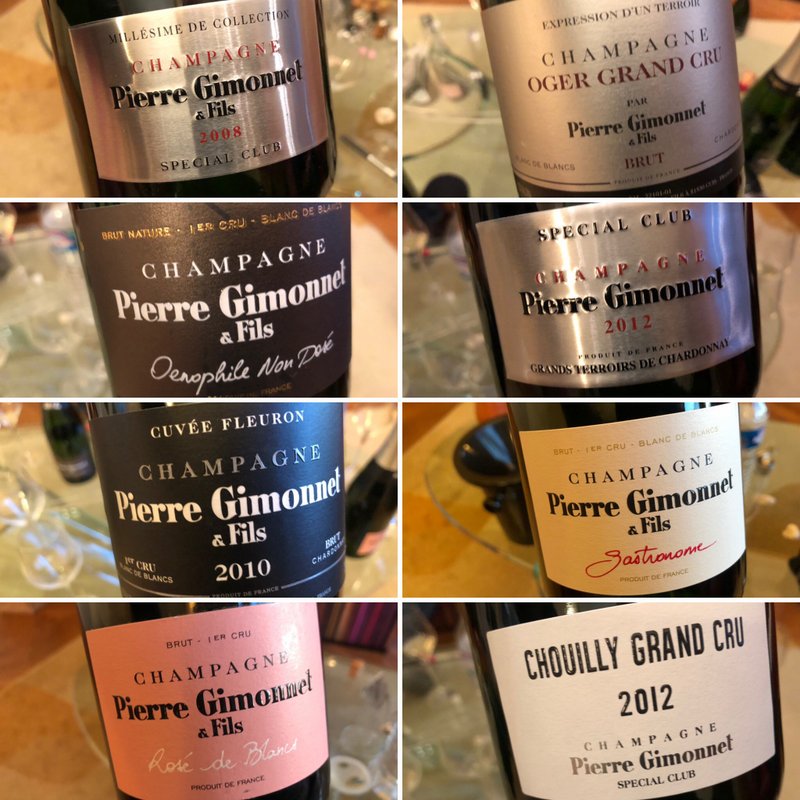
We taste the vins clairs from 2018
Cuis ‘Croix Blanche’ (11.2% alcohol)
4 hectares on chalk. Beautifully aromatic: delicate, fresh and chalky with nice acidity and purity. Very fine. (JG)
Located just behind the house in Cuis, planted in 1991, south facing. Very floral, green edged and delicate, with verbena and green edges. Fresh. (TR)
Cuis ‘Roualles’ (12.55% alcohol)
Stony/chalky soils with clay. Rich pear and citrus fruit with some apricot notes. There’s body and structure here with nice density. *The Cuis Special Club will be a blend of 35% Croix Blanche and 65% Roualles. (JG)
Bigger, powerful, with pure lemon core. Still quite tight and humming on the finish. (TR)
Chouilly ‘Montagies’
Near Cramant. Fine, delicate and expressive. Supple and quite mellow with a slight salty edge to the fruit. Pleasant but lacking real drive. (JG)
Classic Chouilly. Some oxidative kisses, very green lemon verbena. Watery mid palate. Great length. (TR)
Chouilly ‘Ronds Buissons’
Normally this is rustic, but in 2018 it is lively and structured but with some elegance. Fine and poised. (JG)
Located on clay near the top of slopes. Very stony, structural, powerful with lemon and ample white florals. (TR)
Cramant ‘Le Bateau’
Very lively, intense and delicate with a citrussy nose. Mineral on the palate with delicacy and a saline twist. (JG)
From the flats = vin de plain. Lemon-leading, quite structural though fine, with delicacy. (TR)
Cramant ‘Les Buissons’
Brisk with good acidity. Linear, fresh and a bit chalky and salty. Very precise with good acidity. (JG)
East facing slopes. Big and potent, with a chalky grip through the finish. (TR)
Oger
Fine, spicy, citrussy nose. Fresh, lemony, stony palate with good acid and some structure. Focused. (JG)
Big white florals, lemon pith. Quite powerful and more plentiful on the palate. (TR)
Bottled wines
Champagne Pierre Gimonnet Cuis 1er Cru Blanc de Blancs NV France
The base of this is 2015 and it contains six vintages from 2014-2010, with 33% reserve wines. Dosage 6 g/litre. Crisp, focused and delicate on the nose with lovely citrus fruit as well as some white peach notes. Lovely precision. Freshness and acidity rule, but there’s some depth on the mid-palate. Lovely balance and purity. 93/100 (JG)
This wine, like all of their chardonnay-centric wines, is crystal crisp and bright, with driving linearity through to the lingering finish. Based on the 2015 harvest, this has 35% reserve wines from the previous 4 harvests to provide depth and complexity. This bottle was disgorged in January 2019 at 6 g/l, and ringing youthfully. Lemon pith leads into a very chalky, grippy and taut palate, with tiny white blossoms, green apple, meringue, and a shimmery vibrance. Fresh on the attack, though the core is polished by the reserve wines, this is an excellent solo sipper as well as oyster mate. 93/100 (TR)
Champagne Pierre Gimonnet Extra Brut NV France
2013 base (70%), 2012 (30%) and some 2012 and 2009. Disgorged April 2018, dosage 4 g/litre. Some toast and nut on the nose with taut citrus fruit. Lovely savoury richness here with some depth and toastiness, as well as hazelnut and almond and a twist of spicy apple. 92/100 (JG)
This is the same vineyard blend as the Cuis 1er Cru, but with 2 years more on lees, and 4 g/l dosage. Based on 2013 vintage, with reserves from 2012 and 2009. Didier began making this upon request for his importer in the west coast of the United States 2 years ago, and it’s just been released more widely in January 2019. Some oxidative notes here, with kisses of orange, red and green apple, and whiffs of spiced caramel along with roasted nuts. 91/100 (TR)
Champagne Pierre Gimonnet Rosé de Blancs 1er Cru NV France
Didier Gimonnet says that he wants to make a Blanc de Blancs with colour, with the Chardonnay dominating the Pinot Noir. The base here is 2016 and it contains 8% Bouzy Pinot Noir, with a 5.5 g/l dosage. Disgorged December 2018. Delicate and pure with supple red cherry and lemon fruit. Bright with lovely elegance. Very linear and pure and quite delicate. 93/100 (JG)
According to Didier, he wants to have a rosé that tastes like a Blanc de Blancs with colour. ‘Powerful chardonnay.’ This certainly succeeds. This bottling sources fruit from Cramant, Oger, and Chouilly, with an addition of 8% Bouzy still pinot noir. This bottle was disgorged in December 2018, and was based on the 2016 harvest. Pouring a very pale hue, this streams cherry and raspberry, with fine tight florals along a fresh, saline palate. The finish shimmers with minerality and lingers with a bitter cherry kiss. Very food friendly, and inviting for solo smashing also. 92/100 (TR)
Champagne Pierre Gimonnet Gastronome 1er Cru 2014 France
18% Cramant, 28% Chouilly, 10% Oger, 9.5% Vertus, 34.5% Cuis, 5 g/l dosage, disgorged July 2018. Fine and subtly toasty with nice lemony fruit. Delicate and precise with some yellow plum and white peach. So fine and elegant with amazing purity, and fine toasty notes on the finish. Very easy to drink. 94/100 (JG)
This is 60-70% grand cru fruit (mainly Chouilly) with the rest coming from Cuis, and was designed to be a more powerful version of Cuis 1er Cru, ideal for restaurants and food matches. Stony and firm, with tight lemon pith and peel, meringue, and chalk. Quite vinous, with lovely length. 93/100 (TR)
Champagne Pierre Gimonnet Fleuron 2010 France
This is the wine that tries to capture the spirit of the vintage. Disgorged in July 2018 with 5 g/l dosage. This was not an easy vintage but the result is lovely. Lots of toast and spice on the nose with citrus fruit and lots of spice. Focused and quite elegant with the delicate character of the north of the Côte des Blancs, with some fine cheesy hints and a silky texture. Vinous. 94/100 (JG)
Fleuron was created to capture the spirit of the vintage, and is a blend of all of the tanks in order to best represent the year. This encompasses 5 villages: Chouilly, Cramant, Oger, Cuis, and Vertus. After 7 years on lees, this was bottled in 2018. Rich and powerful, with salted brioche, savoury earth and a hum of minerality. Lovely harmony, complexity, and completeness, with fantastic length. 94/100 (TR)
Champagne Pierre Gimonnet Oenophile Non-Dosé 2012 France
The same blend as Fleuron, with no dosage. Lean and pure with elegance and freshness. Great precision and pure fruit are the hallmarks with a taut personality. Dry with harmony. 94/100 (JG)
This is the same as Fleuron, but with no dosage. Tight and nervy with acidity, and energy. Anise, lemon, and green apple run the very lengthy, streamlined palate, with salted spices on the end. 93/100 (TR)
Champagne Pierre Gimonnet Special Club Chouilly Grand Cru 2012 France
This is from the lieu dit Montagies, bottled April 2013 and then disgorged April 2018 with a dosage of 4 g/l. Fine, fresh lemony nose with lovely precision, and notes of anise. The palate shows chalky, mineral characters with lovely focus and purity. Fine-grained, lemony and delicate. So expressive. Didier Gimonnet says that this takes him back to when he was young, in a Proust madeleine moment, to the identity of the house. Has depth but stays elegant. 95/100 (JG)
This is their only cuvee from a single lieu dit: Montagies. Five years on the lees, with a dosage of 4g/l. Deep chalk, anise, green apple, lemon pith, biscuit, all woven within layers of complexity. Fantastic length and minerality on the finish. 95/100 (TR)
Champagne Pierre Gimonnet Special Club Grands Terroirs de Chardonnay Brut 2012 France
60% Cramant, 30% Chouilly, 10% Cuis. Bottled April 2013, disgorged October 2018, dosage 4 g/litre. Complex nose of fine, delicate citrus fruit with subtle toast and fine citrus notes. The palate is linear and focused with brilliant lemon notes, some chalk, some salinity and real focus and precision, as well as a hint of almond. 96/100 (JG)
This blend was 60% Cramant, 30% Chouilly, 10% Cuis, bottled April 2013, and disgorged in October 2018 with 4 g/l.Powerful and richer style, with patisserie, lemon oil, mineral salts. Showing some mature depth through the mid, with a chalky, lemon astringency on the finish. Very complete. 95/100 (TR)
Champagne Pierre Gimonnet Oger Grand Cru Blanc de Blancs NV France
90% 2016, 10% 2015, disgorged July 2018. Didier Gimmonet bought this plot in Oger in 2005 thinking it would increase the complexity of his blends, but it’s not what he wants. At least it’s easy for him to sell this wine! This is taut and focused with some graphite and some herbs, as well as fennel, green pepper and herbs. Very expressive and linear. Tight and compact and a bit angular. It’s complex. A food wine. Vinous. 93/100 (JG)
Based on 2016, with 10% from 2015, and disgorged in July 2018 with 5 g/l. Quite different from his wines in the northern Côte des Blanc, with austere, smoked graphite notes, lemongrass, white blossoms across an expansive palate. Acidity still rings on the finish, tightening this up smartly. 92/100 (TR)
Champagne Pierre Gimonnet Special Club Millesime de Collection 2008 France
Nine years on lees. Very fine nose with toast, anise and lemons, as well as some baked bread. It has an elegant palate with a surge of energy and lovely precision, with fine toasty notes, some almond and fine herbs. Lively and precise, showing keen acidity and amazing length. 96/100 (JG)
Unreleased, this spent 9 years on lees. Deep chalk and mature notes, with thrust of lemon, broken stones, and streaming with fine, precise acidity that carries this long. Very elegant even now in youth; time to go. 94/100 (TR)
Champagne Pierre Gimonnet Special Club Cramant Grand Cru Extra Brut 2012 France
Vines planted 1911-1982. Lieux dits Buissons, Hautes Bauves, Le Bateau, Bionnes and Champs de Prévot. Bottled in April 2013 and disgorged in April 2018. Dosage 4 g/litre. This is taut and focused with some herb, pear and citrus fruit. Slightly saline. This has some grapefruit and citrus pith notes. Fine and detailed with some juiciness. 93/100 (JG)
Poured from magnum. From Lieux dits Buissons, Hautes Bauves, Le Bateau, Bionnes and Champs de Prévot, and vines planted 1911-1982. Bottled in April 2013 and disgorged in April 2018 at 4 g/l. Softer on the palate, with meringue, lemon, patisserie, and light cream, finishing with lingering lemon pitch. 92/100 (TR)
Goode’s Older notes from 2017
Champagne Pierre Gimonnet Cuis Premier Cru NV France
100% Chardonnay, 2012 base wine, reserves kept in bottle, 18-30 months ageing on lees, full malolactic, 8 g/l dosage. This shows lovely focus with taut citrus fruit, some fine herbs and nice brightness. A really lovely pure Blanc de Blancs. 92/100 (JG)
Champagne Pierre Gimonnet Fleuron 1er Cru 2010 France
100% Chardonnay. 30% Chouilly, 42.5% Cramant, 9% Oger, 18.5% Cuis. Full malolactic and a dosage of 4.5 g/litre. This is very focused and lemony with tight, pure citrus fruit. Pristine and focused with amazing purity and keen acidity. Just so fine and focused with real finesse. 95/100 (JG)
Champagne Pierre Gimonnet Oenophile Non-Dosé 1er Cru 2008 France
100% Chardonnay. Essentially Fleuron with nose dosage: in this vintage 33.5% Cramant, 32.5% Chouilly, 10% Oger, 22% Cuis, 2% Vertus. Full malolactic, then 6 years on lees. Beautifully poised and elegant with real finesse. Lovely tight lemony fruit with some density, but also real elegance. Subtle notes of wax, herbs and pith. Very pure. 95/100 (JG)
Champagne Pierre Gimonnet Gastronome 1er Cru 2012 France
100% Chardonnay from Chouilly (38%), Cuis (17%), Cramant (24%), Oger (10%), Vertus (11%), fermented in stainless steel with malolactic. 4 years on lees, and dosage of 6.5 g/l. Less pressure, in order to make it gastronomic. This has lovely complexity with taut citrus fruit, some baked apple richness, and some yellow plum. Lively and complex, filling the whole palate. Textured with some structure and kept fresh with keen acidity. 94/100 (JG)
UK agent: Armit Wines
Find these wines with wine-searcher.com

